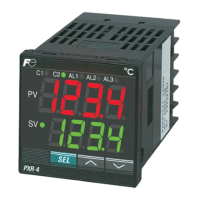– 11 –
2Wiring
u
i
o
!0
!1
!2
Relay output
CT input
!1
!2
!1
!2
Control output2
SSR/SSC drive output
Current output
+
-
Digtal input
CT input
CT input
RS485 com.
+
-
Digtal input
RS485 com.
+
-
Remote SV input
RS485 com.
+
-
Remote SV input
Digtal input
u
i
Re-transmission output
Re-transmission output
+
-
u
i
Digtal input
Remote SV input
+
-
+
-
u
i
u
i
u
i
u
i
u
i
o
!0
o
!0
!1
!2
!1
!2
o
!0
o
!0
o
!0
o
N.C.
DI1
DI2
Digtal input
!0
+
-
!1
!2
+
-
!1
!2
· Common
· Alarm output1 (AL1)
· Alarm output2 (AL2)
· Heater break
Alarm output3 (AL3)
50/60Hz
Control output1
Alarm output
Power supply
(Note2)
(
Note1
)
Relay output
Thermocouple
Resistance bulb Current/voltage
Current output
uq!3
iw!4
oe!5
!3
!4
!3
!4
!3
!4
!5
+
A
B
B
-
+
-
+
-
+
-
!0r
q
w
e
r
!6
!1t!7
!2y
t
y
!8
!6
!7
!8
!7
!8
!7
!8
100-240V AC
SSR/SSC drive output
Measured value input
Note 1 : Check the power supply voltage before installation.
Note 2 : Connect the I/V unit (250Ω resistor) (accessory)
betweenthe terminal !7 and !8 in case of current
input.
In the case of 1 digital input
point (the 11th, 12th, or 13th
digit of the code symbol is “S00”),
connect the digital input terminal
between terminals u and i.
In the case of 2 digital input points + heater break alarm,
or 2 digital input points + remote SV specifications, connect the CT
input and remote input terminals between terminals !1 and !2.
t
y
24V AC/DC
+
-
Terminal Connection Diagram (100 to 240
AC, 24V AC/24V DC
)

